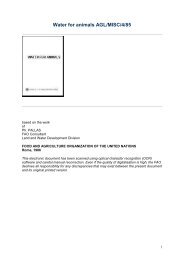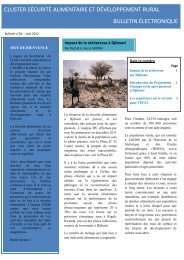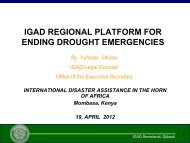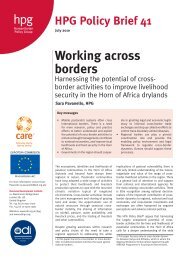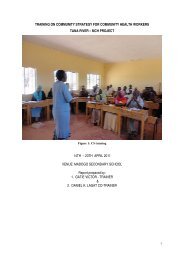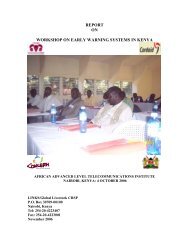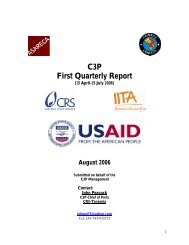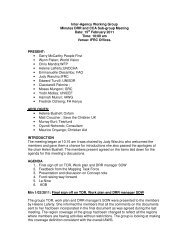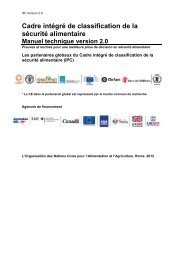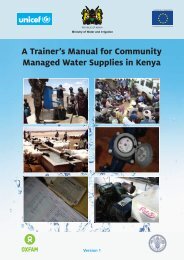Synthesis of Existing Knowledge and Experience on the Provision of ...
Synthesis of Existing Knowledge and Experience on the Provision of ...
Synthesis of Existing Knowledge and Experience on the Provision of ...
You also want an ePaper? Increase the reach of your titles
YUMPU automatically turns print PDFs into web optimized ePapers that Google loves.
Secti<strong>on</strong> 4. Less<strong>on</strong>s learned <str<strong>on</strong>g>and</str<strong>on</strong>g> ways forward4.1 Less<strong>on</strong>s learnedTable 6 presents ‘good’ <str<strong>on</strong>g>and</str<strong>on</strong>g> ‘poor’ practice as identified by practiti<strong>on</strong>ers interviewed in Addis Ababa<str<strong>on</strong>g>and</str<strong>on</strong>g> in <strong>the</strong> regi<strong>on</strong>s (SNNPR, Somali <str<strong>on</strong>g>and</str<strong>on</strong>g> Afar). This table highlights comm<strong>on</strong> resp<strong>on</strong>ses from over 40interviews with water development practiti<strong>on</strong>ers including government, NGOs/developmentorganizati<strong>on</strong>s, as well as d<strong>on</strong>ors, researchers, experts in pastoral development <str<strong>on</strong>g>and</str<strong>on</strong>g> pastoralassociati<strong>on</strong>s. Poor practice generally refers to practices/approaches seen to be problematic, whilegood practice refers to those observed to work within <strong>the</strong> pastoral c<strong>on</strong>text. Having said this, verylittle has been d<strong>on</strong>e in <strong>the</strong> way <str<strong>on</strong>g>of</str<strong>on</strong>g> assessing <strong>the</strong> impacts <str<strong>on</strong>g>of</str<strong>on</strong>g> water development <strong>on</strong> livelihoods. Theseassessments would better help practiti<strong>on</strong>ers make informed choices regarding ‘best’ approaches todeveloping water in <strong>the</strong> rangel<str<strong>on</strong>g>and</str<strong>on</strong>g>s vis-à-vis poverty reducti<strong>on</strong> <str<strong>on</strong>g>and</str<strong>on</strong>g> increasing livelihood resilience 50 .Table 6: ‘Good’ <str<strong>on</strong>g>and</str<strong>on</strong>g> ‘bad’ practice as identified by <strong>the</strong> water development community <str<strong>on</strong>g>of</str<strong>on</strong>g> practice inEthiopiaGood practice• Underst<str<strong>on</strong>g>and</str<strong>on</strong>g> <strong>the</strong> broader natural resourcebase <str<strong>on</strong>g>and</str<strong>on</strong>g> grazing patterns before planning<str<strong>on</strong>g>and</str<strong>on</strong>g> c<strong>on</strong>structing water points - i.e. makingwater development part <str<strong>on</strong>g>and</str<strong>on</strong>g> parcel <str<strong>on</strong>g>of</str<strong>on</strong>g>natural resource management recognizingthat water affects <strong>the</strong> way broader naturalresources are used <str<strong>on</strong>g>and</str<strong>on</strong>g> managed.• Underst<str<strong>on</strong>g>and</str<strong>on</strong>g> local c<strong>on</strong>texts <str<strong>on</strong>g>and</str<strong>on</strong>g> dynamics,including social, political <str<strong>on</strong>g>and</str<strong>on</strong>g> culturalaspects in a given locati<strong>on</strong>.• Identify existing water points <str<strong>on</strong>g>and</str<strong>on</strong>g> exploreopti<strong>on</strong>s for rehabilitati<strong>on</strong> (improve <strong>on</strong>what is already <strong>the</strong>re).• Couple water development with o<strong>the</strong>rpastoral development interventi<strong>on</strong>s (e.g.access to markets, veterinary health,rangel<str<strong>on</strong>g>and</str<strong>on</strong>g> rehabilitati<strong>on</strong>)Poor practice• Establishing water points withoutunderst<str<strong>on</strong>g>and</str<strong>on</strong>g>ing <strong>the</strong> local c<strong>on</strong>text (social,political, cultural, <str<strong>on</strong>g>and</str<strong>on</strong>g> ec<strong>on</strong>omic)• C<strong>on</strong>structing water points with littleknowledge <str<strong>on</strong>g>of</str<strong>on</strong>g> o<strong>the</strong>r natural resources in<strong>the</strong> area <str<strong>on</strong>g>and</str<strong>on</strong>g> how people use <strong>the</strong>seresources; i.e. without c<strong>on</strong>textualizingwater within <strong>the</strong> broader l<str<strong>on</strong>g>and</str<strong>on</strong>g>scape.• Heavy emphasis <strong>on</strong> c<strong>on</strong>structi<strong>on</strong> withinsufficient attenti<strong>on</strong> to planning,management, operati<strong>on</strong>, maintenance.Implementati<strong>on</strong> by external agents withlittle <strong>on</strong> <strong>the</strong> ground c<strong>on</strong>sultati<strong>on</strong> <str<strong>on</strong>g>and</str<strong>on</strong>g>involvement.• Promote meaningful engagement withwater users in <strong>the</strong> planning <str<strong>on</strong>g>and</str<strong>on</strong>g>implementati<strong>on</strong> phase <str<strong>on</strong>g>of</str<strong>on</strong>g> any interventi<strong>on</strong>s<str<strong>on</strong>g>and</str<strong>on</strong>g> promote <strong>the</strong> use <str<strong>on</strong>g>of</str<strong>on</strong>g>participatory/c<strong>on</strong>sultative methods.50 Most projects currently focus <strong>on</strong> reporting outputs at <strong>the</strong> expense <str<strong>on</strong>g>of</str<strong>on</strong>g> quality or effectiveness. For example,a report which states that ’10 wells were improved’ does not say anything about accessibility, availability,affordability, quality <str<strong>on</strong>g>and</str<strong>on</strong>g> acceptance – <strong>the</strong> five st<str<strong>on</strong>g>and</str<strong>on</strong>g>ard indicators <str<strong>on</strong>g>of</str<strong>on</strong>g> service provisi<strong>on</strong> (Ministry <str<strong>on</strong>g>of</str<strong>on</strong>g> Agriculture<str<strong>on</strong>g>and</str<strong>on</strong>g> Rural Development, 2008: 14)51 The government’s PCDP for example requires community c<strong>on</strong>tributi<strong>on</strong> <str<strong>on</strong>g>of</str<strong>on</strong>g> 15 per cent, 5 per cent <str<strong>on</strong>g>of</str<strong>on</strong>g> whichis expected in cash.52 This fits with <strong>the</strong> government’s short-term strategy <str<strong>on</strong>g>of</str<strong>on</strong>g> supporting mobile pastoral livelihoods.69



